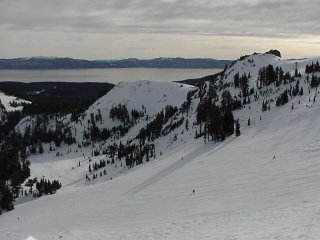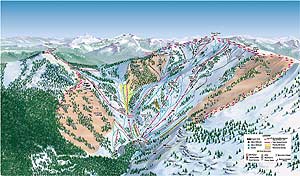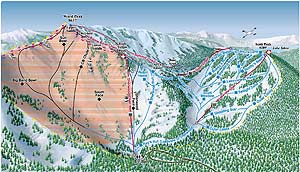Tahoe City, CA – First light, and the chirping alarm did
little more than elicit an anguished groan from my daughter Jacquelin, age 14.
It was 6:00 AM and less than nine hours since we had last been on the snow,
tubing our hearts out at Squaw Valley. Frankly,
the attitudes of son Jonathon, 10, and my dutiful partner, Briar, weren’t
much more enthusiastic. And after all, what could possibly top mighty Squaw
Valley, adrenalin capital of West Coast skiing?
|
(photo Marc Guido) |
At first blush, Alpine Meadows doesn’t
look much like a mega-resort when you read its paper stats. Twelve lifts and
an understated l,802-foot vertical rise. Not small, yet certainly not overwhelming
with 2000 acres of skiable terrain, especially with its long-standing reputation
as a low key, family-oriented resort where simply having a great time is far
more important than how you look hucking the chutes. Little to our knowledge,
our family was about to be given a lesson in “exceeding expectations”
because, simply put, Alpine Meadows is the proverbial “little” place
that rocks.
If you haven’t figured it out
already, we eastern ice-rats came to ski. And, as I alluded to in earlier articles,
we were by now on Day Five of a whirlwind six-day/six-resort tour of the Tahoe
area. The early morning Southwest Air whistle stop flight from Detroit seemed
like it had occurred a century ago. The daily ritual of hustling around before
dawn putting together four boot bags full of ever more odious ski socks, glove
liners and boots had fallen more and more under my own private purvey. I actually
didn’t mind the task, because I figured that obligated Briar to perform
the even less enviable task of packing our lunch bags full of slopeside sustenance
from our ever-dwindling supply of the airline-issue honey roasted peanuts, quasi-chicken
flavored pepperettes, and enough beef jerky to feed the Sioux nation for the
remainder of the winter. All the while keeping within the USDA daily food guide.
.
Alpine Meadows is one of those rare
resorts where the overall experience is far greater than the sum of its individual
statistics should ever give it a right to be. Lying essentially one ridge south
of press-hog Squaw Valley, Alpine Meadows plays yang to Squaw Valley’s
yin. Alpine Meadows exists in a parallel universe to Squaw, but usually boasts
deeper average snowfalls and the longest season in the Tahoe area, mainly as
a result of its slightly higher base elevation and favorable aspect. Couple
those facts with some of the sweetest groomed cruisers, sickly-steep cornice
encrusted bowls, gnarly bump runs and magnificent lake views, and Alpine is
truly a gem.
For several years I had been perusing
the national ski rags and wondering how such a modest-sounding resort consistently
ranked near the top of far-west ski areas. As I said, l,802 vertical feet doesn’t
sound like a lot in western terms. Well, the place skis like it might as well
have 2,802 vertical feet – or maybe bigger. Trust me – one will never go lacking
for variety here.
|
Click on /images to open full-size trail maps in a new browser window |
Alpine Meadows is a somewhat difficult
mountain to visualize, and for that matter, to accurately represent on a two-dimensional
trail map. I’ll take a stab at it in print. Picture two long ridgelines
in the shape of a curvy capital “T”. The leg of the “T”
curves roughly east. The longer of the two top bars of the “T” squirrels
along from a northeast to southwest direction. Two small mountain peaks erupt
at about the midpoint of each ridgeline, Scott Peak in the leg, and Ward Peak
in the top bar. Runs spill off in virtually all directions from the wavy ridgelines
except the back (west) side of the top bar. A series of immense bowls hang
under the east and southeast facing aspects of the top bar of the “T”
under Ward Peak. Many of the steep bump runs cling to the north side of Scott
Peak off the leg of the “T’. This makes for virtually 360 degree
aspect skiing at several points in the resort, any of which are available for
prime skiing under varying snow and temperature conditions. Got it? (No!
–Ed.)
We left our quaint and funky accommodations
at the Tamarack Lodge in Tahoe City (which I highly recommend, by the way) and
made the roughly ten minute drive north on Highway 89 toward Truckee. Turning
left onto the Alpine Meadows access road, we pulled into the resort’s large,
uphill-sloping parking area. There is no lodging directly slopeside at the
resort. After what I had gleaned from all the glossy ski rags I’d read
over the years, I had been anticipating a barely adequate base facility. In
reality, the one that I found was large and comprehensive, done up in a tasteful
woodsy green and brown log theme. Quite honestly, I would have to say the operative
description was sort of an understated yet imposing “rusticity”. Tons
of boot changing room, a beautiful, high-ceilinged cafeteria and the biggest,
brightest sundeck in the Tahoe area round out and add to the charm of the facility.
In short, unless you’re a fur-coated ski diva, the resort need not feel
like anyone’s poor cousin.
Matching its appearance, Alpine Meadows
prides itself on being a family-friendly, service-oriented resort. Granted,
much of the terrain is more suitable for the family member you don’t talk
about in polite company, but more on that later. This is the type of service
that seemingly no longer exists at many other areas in North America – indeed
if it ever existed at all. For example, Alpine operates a daily free
supervised ski check facility beside the sundeck, which, to the best of my knowledge,
is the only one of its kind in the Tahoe area. Frankly, it had been a long
time since I visited an area where I didn’t feel like the resort was digging
into my pocket at every turn. It’s a simple touch, but a very welcome
one.
|
(photo Marc Guido) |
I left Briar and the kids to boot up
while I sought up Robert Olmer, Marketing Director for the resort. A commanding
and knowledgeable fixture on the Tahoe scene for some time, Olmer was as low
key as his resort. His quiet singing of the praises of his resort made it easy
to understand why Alpine Meadows was such a Tahoe locals’ favorite. Utilizing
a minimum of hype, he rehashed Alpine’s relatively short history and laid
out its projected future. In comparison to, for instance, Squaw Valley or Sugar Bowl, Alpine Meadows
is a relative newcomer on the Tahoe ski scene. The first lifts were strung
up Ward peak in 1962, with the original base lodge completed shortly thereafter.
Since then, Alpine Meadows has developed
at a measured and steady pace, its growth rate a stark contrast to the often
frenetic expansion exhibited by its neighbor to the south. Sharing communal
ownership with Park City Mountain Resort in Utah, Alpine Meadows emulated its
sister as one of the last North American holdouts in allowing snowboards. In
l996, the snowboard ban at Alpine Meadows was finally rescinded, in conjunction
with the similar change of policy at Park City. As Olmer explained, this was
less of an attempt to bolster the bottom line than an effort to maintain its
family base. “It wasn’t so much whether we actually wanted or didn’t
want snowboarding on the mountain,” he indicated. “You have to remember,
this place prided itself on being the Tahoe resort of choice for a couple of
generations of hard-skiing families. We discovered that many of the children
in those families took up snowboarding, and the families were literally forced
to patronize the other resorts so long as the ban was in place. Consequently,
we decided to lift the ban in l996. As a result, many of those families have
since come back into the fold here. We think that fact, more than anything,
attests to the enduring attraction of Alpine Meadows.”
Olmer then introduced me to Ryan Icanberry,
an integral part of the resort’s brash young management/marketing team
that Alpine has assembled. As outgoing as Olmer was reserved, our guide-to-be
typified the youthful exuberance which was to be in abundant evidence on the
slopes that day. The five of us headed for the loading zone of the Roundhouse
High Speed Quad for a quick warm up run. This chair cruises to the approximate
mid-point of Ward Peak and is the jumping off point for many of the intermediate
cruiser runs. Because its top station is relatively sheltered, it can often
run when the adjacent Summit Six is on wind hold.
I quickly discovered that Icanberry
was an excellent boarder, one of those individuals who can seemingly launch
a hit off of every fist-sized chunk of upended sun crust. After the quick warm-up,
we loaded on the high speed Summit Six, Alpine’s workhorse chair, and rode
to the top of Ward Peak. At the summit, our guide pointed to skier’s right
toward the vast expanse of the somewhat prosaically named Alpine Bowl, one of
the resort’s more popular areas. Turning to skier’s left, three more
immense bowls loomed: Wolverine Bowl, Beaver Bowl, and Estelle Bowl, respectively,
receded northeast far into the distance.
Icanberry explained that Alpine is
renowned for its liberal and progressive inbounds hike-to policy, as well as
its open boundary policy covering the truly out-of-bounds areas. While no lifts
directly service the outer in-bounds bowl areas, all of these are fully patrolled,
swept and bombed as required to ensure safe conditions. Somewhat uniquely for
such an expansive sweep of terrain, most of the bowls actually require only
a moderately short traverse at both top and bottom, as the resort’s layout
effectively funnels even the longest traverse-to runs back to one or another
of the base lifts.
Sweeping down through Alpine Bowl,
we crossed east through the base area and mounted the Scott Triple Chair to
the top of Scott Peak. The lift offers an entertaining view of skiers careening
down the mogulled and near-vertical face of Scott Chute, beneath. Later, I
thought … later. Arriving at the top, Icanberry guided us along a lengthy
southwest traverse, at the end of which we swept down Twilight Zone. This
area of Scott Peak is serviced by the Lakeview Triple, the epicenter of a blue
cruiser’s paradise. As we rode up and unloaded at the top of the Lakeview
Chair, Icanberry pointed east off the back of the resort. The top of the Lakeview
Chair affords – surprise! – a stunningly beautiful vista of an aquamarine Lake
Tahoe. Playing touron once again, we snapped a few memorable photos.
Dropping southwest toward the base
of the chair, and traversing far west below that along Ray’s Rut, we eventually
reached the far southwestern tip of the resort and found the Ice Bar, Alpine’s
other base area. The description “base area” might be a bit generous
for the small, isolated outpost. Icanberry explained the building was an extremely
popular afternoon pizza-and-brew-dispensing-facility, and told us to make sure
we checked it out later in the day.
Ice Bar is situated at the base of
another immense low-expert/advanced south facing bowl named, not surprisingly,
Sun Bowl. Far off to the west lay a seemingly endless cornice-capped ridgeline
known as Big Bend Bowl. This area does require a bit of traversing, both to
reach it and also to return. I would suggest the hike would be well worth it
on a new powder day. However, we were now into our fifth bluebird day of warm
temperatures and zero freshies. It was about 11:00 AM, and the combination
of brilliant sunshine, sixty-degree temperatures and the south facing aspect
of this part of the resort was already conspiring to turn both Sun and Big Bend
Bowls into mashed potatoes … or worse.
Icanberry took us up and over the ridgeline
on the Sherwood Triple, and the excellent snow preservation afforded by the
north-facing slopes on the other side provided virtually mid-winter conditions.
This area of the mountain offers a steep series of double-black shots funneling
down to one of Alpine’s most interesting areas, Hot Wheels Gully. Similar
to Kirkwood’s terrain,
the Hot Wheels Gully forms a vast natural half-pipe full of hits and tree islands.
Our guide worked the sides of the “pipe” like a pro, with Jonathon
whooping in hot pursuit. As we funneled out into the Hot Wheels Chair base
area, Icanberry excused himself from the tour for prior (and likely less fun)
business matters.
|
(photo Marc Guido) |
Alpine Meadows does not possess a huge
number of lifts when compared to Squaw Valley, but their modern and efficient
layout effectively disperses crowds throughout the resort area without a whimper,
just the same. We headed up the Summit Six and worked the long blacks off Alpine
Bowl until lunch. The runs in Alpine Bowl effectively allow a family to separate
by ability on the way down and meet up with each other at the bottom. Much
of the terrain is of the black cruising variety, but the area is not without
its small cliff areas and tough mid-slope traverses into Wolverine Bowl.
At about 1:00 PM, lunch beckoned.
As previously indicated, Alpine Meadows possesses a simply awesome sundeck at
the back of the base lodge. Many locals with whom we spoke pronounced it the
best in the Tahoe area. Frankly, although High Camp at Squaw is damned impressive
in its own way, this was a sundeck built to my own personal tastes – laid back,
cool tunes, and friendly people. Oh, and the free ski check and cheap beer doesn’t
hurt either.
After a quick bite of reasonably priced
food in the cafeteria, we again made our way to Scott Peak. I had my eye on
Scott Chute and the “Promised Land,” a hike-to area to the northeast.
I soon discovered that Scott Chute was one of those runs which proves the old
adage “it never seems as steep from the lift”. Despite soft hero
snow on the run, much of the upper third of the chute required jump turns from
mogul top to mogul top. Ten minutes and a lot of sweating later, my by now
lactose-deficient leg muscles demanded that we head elsewhere for a couple of
runs.
By popular vote, and in accordance
with Icanberry’s parting recommendation, we again headed up the Scott Chair
and began the long traverse over to Sun Bowl and Sherwood Forest. For those
of you who haven’t been there, Sherwood Forest is an absolute delight.
One of the most beautiful areas to ski in all of Tahoe, the Forest is a lightly
gladed and secluded area of blue-black pitch. It was easy to see why many advanced-level
families gravitate to this area of the resort and ski there most of the day.
By this time, it was mid-afternoon
and the Ice Bar was beckoning. Sure enough, a small crowd had congregated to
lounge around on the benches and soak up the rays. Pizza and brews were in
ample evidence -on a quasi-self-serve honor system yet!! That, my friends,
is laid back. While Briar and I enjoyed a liquid refreshment, a young liftie
on break struck up a conversation with us. “See that cornice?” he
asked, pointing west beyond Big Bend Bowl. “My buddy and I hiked there
yesterday. I swear that cornice is about a hundred feet deep in the center.
We wondered whether or not it was safe to launch, so my buddy kicked at it a
bit. A piece of snow the size of a school bus dropped out when he did that.
After that, we thought we’d better wait for a day or so before we dropped
it”. Grinning, the liftie hoisted a glass and added, “I love this
place. Where else can you do get away with that kind of stuff just outside the
resort boundary?”
Ah yes, Alpine Meadows. So laid back.
So cool. So family friendly. So “Not Squaw”. Just keep the wild
side a secret between us, OK?





